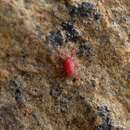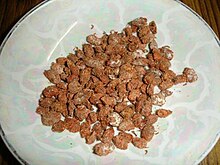en
names in breadcrumbs


Trombidiidae, also known as red velvet mites, true velvet mites,[2] or rain bugs, are small arachnids (eight-legged arthropods) found in plant litter and are known for their bright red color.
While adults are typically 4 mm (0.16 in) in length, some, such as the genus Dinothrombium, may reach up to 12 mm (0.47 in).[2]
Their life pattern is in stages similar to other members of the Prostigmata: egg, pre-larva, larva, protonymph, deutonymph, tritonymph and adult (male or female). They usually have only one breeding cycle per year.[3]
They are active predators as grown adults. As early instars they are often parasites of insects[4] and other arachnids.
One well-known species from Europe, Asia, and North Africa is Trombidium holosericeum.[5] The systematics of this group has been in flux and many former subfamilies of this are now raised to families within the Trombidioidea.[3][6]
According to Joanna Makol[7]

The oil from the red velvet mite Trombidium grandissimum is used in traditional Indian medicine to treat paralysis.[8][9]
Trombidiidae, also known as red velvet mites, true velvet mites, or rain bugs, are small arachnids (eight-legged arthropods) found in plant litter and are known for their bright red color.
While adults are typically 4 mm (0.16 in) in length, some, such as the genus Dinothrombium, may reach up to 12 mm (0.47 in).
Their life pattern is in stages similar to other members of the Prostigmata: egg, pre-larva, larva, protonymph, deutonymph, tritonymph and adult (male or female). They usually have only one breeding cycle per year.
They are active predators as grown adults. As early instars they are often parasites of insects and other arachnids.
One well-known species from Europe, Asia, and North Africa is Trombidium holosericeum. The systematics of this group has been in flux and many former subfamilies of this are now raised to families within the Trombidioidea.